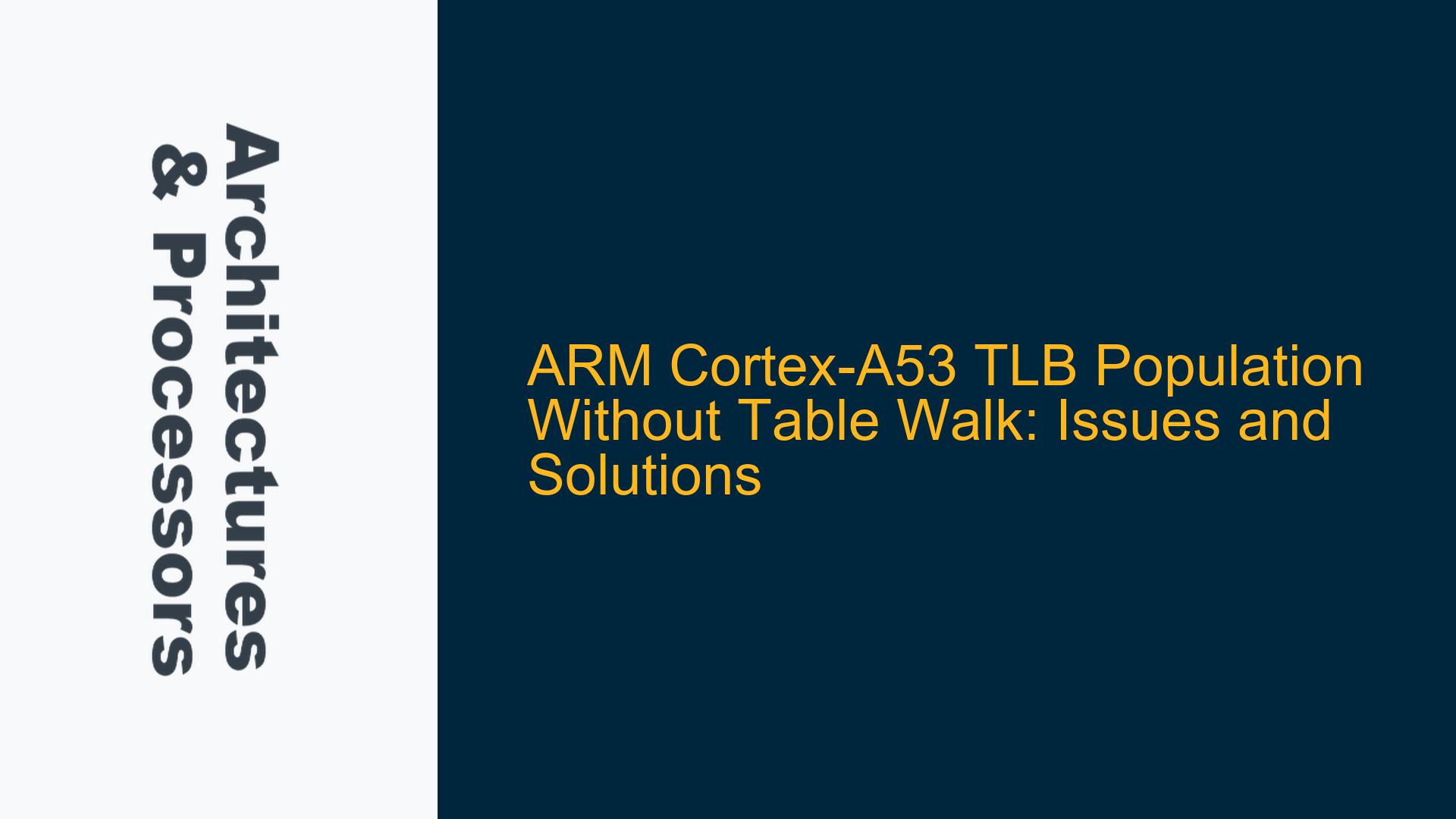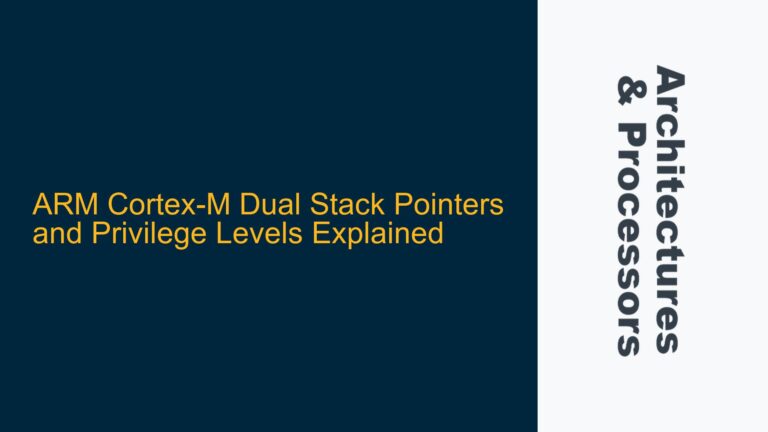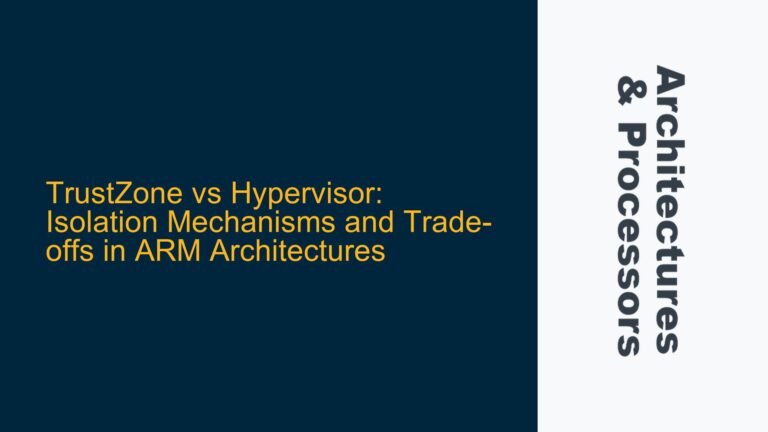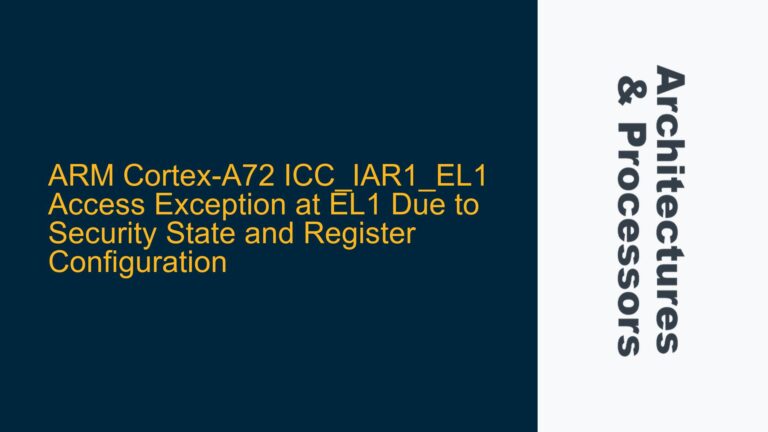ARM Cortex-A53 TLB Population Challenges with EPDx Bits Enabled
The ARM Cortex-A53 processor, a widely used 64-bit core in embedded systems, employs a Translation Lookaside Buffer (TLB) to cache virtual-to-physical address translations, significantly reducing memory access latency. However, a nuanced issue arises when the EPDx (Translation Control Register Exception Permission Disable) bits in the TCR_ELx registers are set to disable table walks. While this configuration can be useful in specific scenarios, such as preventing unnecessary table walks during translation regime updates or when a memory region is unused, it introduces challenges in ensuring that the TLB remains populated with valid entries. This post delves into the technical intricacies of this issue, explores its root causes, and provides detailed solutions for maintaining TLB coherence without relying on table walks.
EPDx Bit Configuration and Its Impact on TLB Coherence
The EPDx bits in the TCR_ELx registers are designed to disable table walks for specific translation regimes. When EPDx is set to 1, the processor skips the table walk process for the corresponding translation regime, assuming that the translation tables are either invalid or not required. This can be beneficial in scenarios where frequent updates to translation tables are being made, and the system needs to avoid redundant table walks. However, this configuration introduces a critical challenge: if a memory location is accessed after the EPDx bit is set, the TLB will not automatically populate with the corresponding translation entry, as the table walk mechanism is disabled. This results in a TLB miss, forcing the system to either handle the exception or rely on software to manually populate the TLB.
The root of this issue lies in the interaction between the EPDx bit configuration and the TLB population mechanism. The TLB relies on table walks to populate its entries with valid translations. When table walks are disabled, the TLB cannot fetch new entries, leading to potential performance bottlenecks or system failures if the required translations are not already cached. This behavior is particularly problematic in systems where memory access patterns are dynamic, and translation entries need to be updated frequently.
Manual TLB Population and Synchronization Techniques
To address the challenges posed by disabling table walks via the EPDx bits, developers must implement manual TLB population and synchronization techniques. These methods ensure that the TLB remains coherent and contains the necessary translation entries, even when table walks are disabled. Below, we explore the key strategies for achieving this:
1. TLB Invalidation and Repopulation
When the EPDx bit is set, the system must explicitly invalidate and repopulate the TLB entries for the affected translation regime. This can be achieved using the TLBI (TLB Invalidate) instructions, which allow software to invalidate specific TLB entries or entire sets of entries. After invalidating the TLB, the system must manually populate it with the required translations. This can be done by accessing the memory locations corresponding to the desired translations, ensuring that the TLB captures the entries. However, this approach requires careful synchronization to avoid race conditions or inconsistent TLB states.
2. Data Synchronization Barriers
To ensure that TLB updates are correctly synchronized with memory accesses, developers must use data synchronization barriers. The ARM architecture provides several barrier instructions, such as DSB (Data Synchronization Barrier) and ISB (Instruction Synchronization Barrier), which enforce ordering constraints on memory operations and instruction execution. When manually populating the TLB, a DSB instruction should be used to ensure that all previous memory accesses are complete before the TLB is updated. Similarly, an ISB instruction should be used to ensure that the processor fetches the updated translations from the TLB.
3. Translation Table Management
In systems where the EPDx bits are frequently toggled, it is essential to maintain a coherent and up-to-date set of translation tables. This involves ensuring that any changes to the translation tables are propagated to the TLB before the EPDx bit is set. Developers can use the AT (Address Translation) instructions to perform explicit table walks and populate the TLB with the required entries. Additionally, the system should implement mechanisms to track changes to the translation tables and invalidate the corresponding TLB entries when necessary.
4. Exception Handling and Fallback Mechanisms
In cases where a TLB miss occurs despite manual population efforts, the system must have robust exception handling mechanisms in place. The ARM Cortex-A53 processor generates a translation fault when a TLB miss occurs and the table walk is disabled. The system must handle this fault by either manually populating the TLB or falling back to a default translation regime. This requires careful design of the exception handler to ensure that the system can recover gracefully from TLB misses.
5. Performance Considerations
While manual TLB population and synchronization techniques can address the challenges posed by disabling table walks, they introduce additional overhead in terms of both execution time and complexity. Developers must carefully balance the benefits of disabling table walks against the performance impact of manual TLB management. In some cases, it may be more efficient to allow table walks and rely on the hardware to manage the TLB, particularly in systems with predictable memory access patterns.
Practical Implementation and Best Practices
To implement the above techniques effectively, developers should follow a structured approach that includes the following steps:
-
Identify the Use Case for EPDx Bits
Before disabling table walks, developers should clearly identify the specific use case for setting the EPDx bits. Common scenarios include updating translation tables, disabling unused memory regions, or optimizing performance in systems with static memory layouts. Understanding the use case helps in designing an appropriate TLB management strategy. -
Design the TLB Management Strategy
Based on the use case, developers should design a TLB management strategy that includes mechanisms for manual TLB population, synchronization, and exception handling. This strategy should be integrated into the system’s memory management unit (MMU) and exception handling framework. -
Implement and Test the Solution
The TLB management strategy should be implemented and thoroughly tested to ensure that it works as expected. Testing should include scenarios with dynamic memory access patterns, frequent translation table updates, and edge cases such as TLB misses and translation faults. -
Optimize for Performance
Once the solution is implemented, developers should profile the system to identify any performance bottlenecks introduced by manual TLB management. Optimization techniques, such as batch TLB updates or caching frequently accessed translations, can be employed to minimize overhead. -
Document and Maintain the Solution
Finally, the TLB management strategy should be documented and maintained as part of the system’s firmware or operating system. This ensures that future updates or modifications to the system can be made without compromising TLB coherence.
By following these steps and leveraging the techniques outlined above, developers can effectively manage TLB coherence in ARM Cortex-A53 systems with EPDx bits enabled, ensuring reliable and efficient operation even in complex and dynamic environments.






